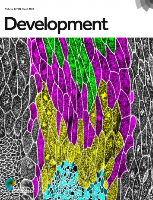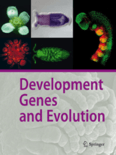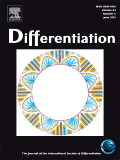
DEVELOPMENTAL BIOLOGY
Scope & Guideline
Advancing the Frontiers of Developmental Research
Introduction
Aims and Scopes
- Molecular Mechanisms of Development:
Research often delves into the molecular pathways and genetic interactions that govern developmental processes, including signaling pathways like Wnt, FGF, and Notch. - Comparative Developmental Biology:
The journal emphasizes comparative studies across diverse taxa, exploring evolutionary aspects of developmental mechanisms that reveal how different organisms adapt their developmental processes. - Regeneration and Repair Mechanisms:
A significant focus on understanding regeneration, particularly in model organisms like zebrafish and axolotls, sheds light on how organisms can repair and regenerate tissues. - Embryonic Development and Stem Cell Biology:
Papers frequently explore embryonic development, including stem cell differentiation, lineage tracing, and the regulatory networks involved in these processes. - Environmental Influences on Development:
Research often investigates how environmental factors, such as temperature and chemical exposure, can impact developmental outcomes, highlighting the interplay between genetics and environment.
Trending and Emerging
- Single-Cell and Multi-Omics Approaches:
There is a growing trend towards using single-cell RNA sequencing and other multi-omics techniques to uncover the complexities of cellular diversity and gene expression during development. - CRISPR and Gene Editing Technologies:
The application of CRISPR/Cas9 and other gene-editing tools is increasingly prevalent, allowing researchers to make precise modifications in developmental studies to elucidate gene function. - Interdisciplinary Approaches:
Emerging themes reflect a cross-disciplinary integration of developmental biology with fields like bioengineering, computational biology, and synthetic biology, enhancing experimental design and analysis. - Modeling Human Development:
Research focusing on human embryonic development using organoid models and stem cell technologies is on the rise, reflecting a broader interest in translating developmental insights to human health and disease. - Regenerative Medicine and Therapies:
There is a notable increase in studies aimed at understanding and harnessing regenerative processes for therapeutic applications, leveraging insights from model organisms to inform human regenerative medicine.
Declining or Waning
- Classical Embryology Techniques:
Traditional methods of studying embryonic development, such as simple morphological assessments, are becoming less common as more advanced molecular and imaging techniques dominate the field. - Invertebrate Development Studies:
There seems to be a waning interest in developmental studies focused solely on invertebrate models, as research increasingly prioritizes vertebrate systems for their relevance to human biology. - Single Species Focus:
Research that concentrates on a single species without comparative or ecological context is less frequent, as the field moves toward more integrative studies that consider evolutionary and ecological dynamics.
Similar Journals

Russian Journal of Developmental Biology
Charting the course of developmental discovery.The Russian Journal of Developmental Biology, published by PLEIADES PUBLISHING INC, serves as a significant platform for researchers and professionals engaged in the field of developmental biology. With the ISSN 1062-3604 and E-ISSN 1608-3326, this journal focused on intricate biological processes and dynamic developmental mechanisms from 2005 until 2017. Although its coverage is currently discontinued in Scopus, it remains notable for its contribution to understanding the pivotal roles of biochemistry and molecular genetics within the context of development. As a publication situated in the competitive quartiles of the field and boasting an influential Scopus rank of #77 out of #78, it has made a unique mark in developmental studies. Researchers and academics seeking to enhance their knowledge of historical advancements in the discipline will find the journal a valuable resource, even as it navigates the transition away from active publication.

INTERNATIONAL JOURNAL OF DEVELOPMENTAL BIOLOGY
Shaping Tomorrow’s Understanding of BiologyThe International Journal of Developmental Biology, published by the University of Basque Country UPV-EHU Press, has been a pivotal resource in the field of developmental biology since its inception in 1989. With an ISSN of 0214-6282 and an E-ISSN of 1696-3547, this journal serves as a platform for groundbreaking research and exploration within the realms of embryology and developmental biology. Although currently classified in the Q4 category for Developmental Biology and Q3 in Embryology as of 2023, the journal continues to provide vital insights that influence contemporary scientific understanding and practices. It ranks 14th out of 21 in the field of Embryology and holds a 35th percentile ranking in this specialized domain, emphasizing its emerging relevance in the academic community. Researchers, professionals, and students alike are encouraged to utilize the journal’s content to enrich their knowledge and drive innovation within developmental sciences. With an eye towards future developments, the journal anticipates continued evolution through the years, maintaining its commitment to high-quality, impactful research.

Cells & Development
Unlocking the Secrets of Cellular DevelopmentCells & Development is a premier journal published by Elsevier, dedicated to advancing the field of Developmental Biology. With an ISSN of 2667-2901 and an impressive Q2 ranking in its category for 2023, the journal endeavors to provide a platform for high-quality research articles that explore cellular mechanisms, developmental processes, and molecular interactions that underpin growth and differentiation. Based in the Netherlands, Cells & Development not only emphasizes the importance of innovative experimental approaches but also encourages interdisciplinary contributions that bridge the gap between basic and applied science. As an Open Access publication, it ensures that research findings are readily accessible to a global audience, significantly enhancing visibility and impact. The journal's commitment to scholarly excellence makes it an essential resource for researchers, professionals, and students aiming to contribute to the dynamic field of developmental biology.

DEVELOPMENT
Illuminating the path of development from molecules to organisms.DEVELOPMENT is a preeminent journal published by COMPANY BIOLOGISTS LTD, headquartered in the United Kingdom. With an ISSN of 0950-1991 and an E-ISSN of 1477-9129, this esteemed journal has been at the forefront of the fields of Developmental Biology and Molecular Biology since its inception in 1987. Recognized for its rigorous peer review process and high-caliber research, DEVELOPMENT holds an impressive Q1 ranking in both disciplines as of 2023, underscoring its pivotal role in advancing scientific understanding. The journal is particularly noted for its contributions to the understanding of developmental processes, their molecular underpinnings, and their implications in health and disease. With a significant impact factor, DEVELOPMENT aims to disseminate groundbreaking research that inspires novel insights and future explorations within the biological sciences, making it an essential resource for researchers, professionals, and students alike. The journal also maintains accessibility for its readership, ensuring that significant research findings reach those who can apply and build upon them.

IN VITRO CELLULAR & DEVELOPMENTAL BIOLOGY-ANIMAL
Pioneering Research in Developmental BiologyIN VITRO CELLULAR & DEVELOPMENTAL BIOLOGY-ANIMAL, published by SPRINGER, is a pivotal journal in the fields of cell biology and developmental biology, focusing on in vitro studies that enhance our understanding of animal cellular mechanisms and development. With an ISSN of 1071-2690 and an E-ISSN of 1543-706X, this esteemed journal offers a platform for researchers to present their findings and contribute to the body of knowledge necessary for advancements in biological sciences. As a recognized publication, it holds a 2023 category quartile of Q4 in Cell Biology and Developmental Biology, and Q3 in miscellaneous Medicine, reflecting its competitive position yet inviting critical submissions that can span multidisciplinary approaches. Though currently not open access, it serves as an essential resource for professionals, researchers, and students dedicated to unraveling the complexities of cellular processes in an ever-evolving field. The journal has been continuously published since 1986, signifying its long-standing commitment to fostering scientific discourse and innovation.

DEVELOPMENT GENES AND EVOLUTION
Advancing Knowledge in Developmental Biology and Genetics.DEVELOPMENT GENES AND EVOLUTION is a prominent academic journal published by Springer, dedicated to advancing the fields of developmental biology and genetics. With an ISSN of 0949-944X and an E-ISSN of 1432-041X, this journal plays a crucial role in disseminating high-quality research that explores the genetic underpinnings of developmental processes across various organisms. Located in the United States, the journal has maintained a strong international presence with a significant impact factor, reflecting its importance in the scientific community. It currently holds a Q3 ranking in both developmental biology and genetics, according to the latest 2023 category quartiles, indicating a solid standing among peers. With a convergence of insights from 1996 to 2024, the journal publishes original articles, reviews, and research notes that attract a diverse readership of researchers, professionals, and students. Access options include traditional subscription models and open access, ensuring that vital research is available to a broad audience. By fostering discussions on the evolution of developmental mechanisms, DEVELOPMENT GENES AND EVOLUTION continues to be an essential resource for those interested in understanding the intricate interplay between genetics and development.

DIFFERENTIATION
Illuminating the Pathways of Molecular ProcessesDIFFERENTIATION is a respected peer-reviewed journal published by Elsevier Science Ltd, dedicated to advancing knowledge in the fields of Cancer Research, Cell Biology, Developmental Biology, and Molecular Biology. With an established history since 1973, the journal continuously explores the intricacies of cellular and molecular processes that govern differentiation in biological systems, thus playing a pivotal role in shaping contemporary research directions. Currently indexed in the Q3 quartile across multiple relevant categories, it provides a crucial platform for researchers to disseminate their findings and engage with the scientific community. DIFFERENTIATION does not offer open access, but it remains a valuable resource for academics seeking to enhance their understanding of the fundamental mechanisms that underpin life sciences. By fostering a rigorous dialogue among scientists, it contributes significantly to the ever-evolving landscape of biochemistry and genetics.

STEM CELLS AND DEVELOPMENT
Fostering Collaboration in Cutting-edge ResearchSTEM CELLS AND DEVELOPMENT, published by Mary Ann Liebert, Inc., is a leading peer-reviewed journal dedicated to the rapidly advancing fields of stem cell biology and developmental science. With an ISSN of 1547-3287 and an E-ISSN of 1557-8534, the journal encompasses a broad range of topics central to understanding stem cells' roles in development and regeneration processes. It holds a prestigious standing within its category quartiles, ranking Q3 in Cell Biology, Q2 in Developmental Biology, and Q2 in Hematology for 2023. With its convergence from 2004 to 2024, STEM CELLS AND DEVELOPMENT fosters an innovative platform for researchers, professionals, and students to disseminate groundbreaking research, share insights, and explore novel therapeutic approaches. Open access options enhance the journal's visibility and accessibility, promoting a collaborative exchange of information among the scientific community. Positioned at the forefront of stem cell research and its applications, this journal is vital for anyone seeking to stay informed about the latest advancements and trends within these critical areas of study.

SEMINARS IN CELL & DEVELOPMENTAL BIOLOGY
Bridging Theory and Practice in Life SciencesSEMINARS IN CELL & DEVELOPMENTAL BIOLOGY is a premier journal published by Academic Press Ltd - Elsevier Science Ltd, focusing on the vital domains of cell and developmental biology. With an impact factor that reflects its rigorous contributions to the field, this journal embodies the highest standards of academic excellence, currently ranking in the Q1 quartile for both Cell Biology and Developmental Biology categories as of 2023. Researchers and practitioners will appreciate its robust Scopus ranking, placing it within the top tiers of developmental biology and cell biology, with percentile ranks of 94th and 90th respectively, showcasing the journal's influential presence in the scientific community. The journal aims to disseminate comprehensive reviews, cutting-edge research articles, and significant advances in the understanding of cellular mechanisms and developmental processes, thereby catering to a diverse audience that includes researchers, scholars, and students dedicated to the life sciences. Given its commitment to open access, SEMINARS IN CELL & DEVELOPMENTAL BIOLOGY promotes widespread dissemination of knowledge, enhancing collaborative research efforts and driving innovation across biological disciplines.

Frontiers in Cell and Developmental Biology
Advancing the frontiers of cellular knowledge.Frontiers in Cell and Developmental Biology is a leading open-access journal published by FRONTIERS MEDIA SA, dedicated to advancing the understanding of fundamental biological processes at the cellular and developmental levels. Since its inception in 2013, the journal has positioned itself as a cornerstone of research in its field, achieving esteemed Q1 quartile rankings in both Cell Biology and Developmental Biology for 2023. With a robust Scopus ranking of #13 out of 82 in Developmental Biology and #67 out of 285 in Cell Biology, it represents a vital platform for innovative research and scholarly discourse. The journal provides a comprehensive and accessible avenue for researchers, professionals, and students alike to share high-quality findings and insights into cellular mechanisms and developmental processes, fostering collaboration and knowledge exchange in the global scientific community. Based in Lausanne, Switzerland, Frontiers in Cell and Developmental Biology is committed to open science, ensuring that all articles are freely accessible to the public, thereby broadening the impact of research in the biological sciences.